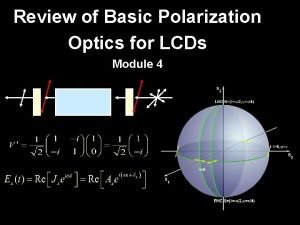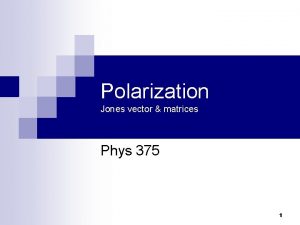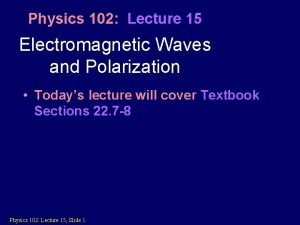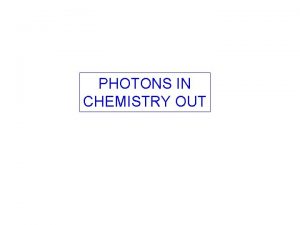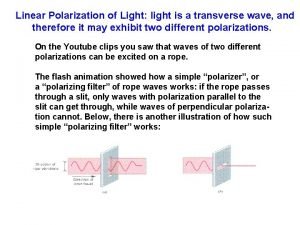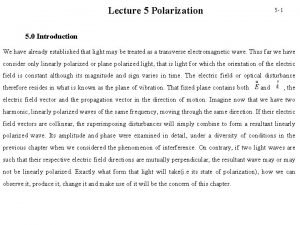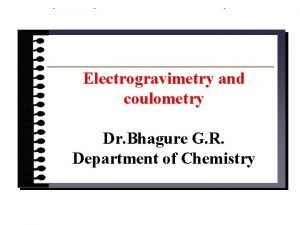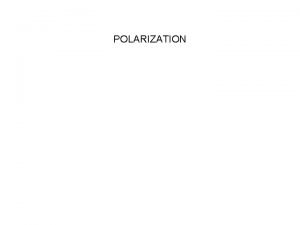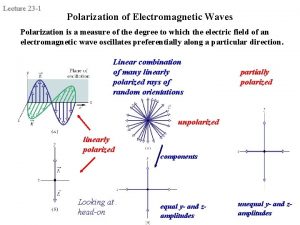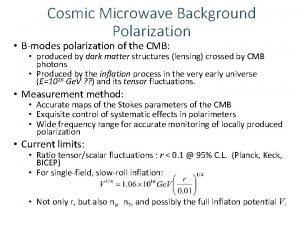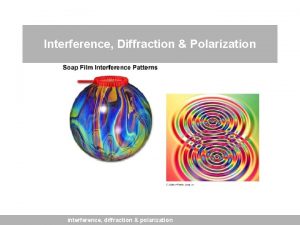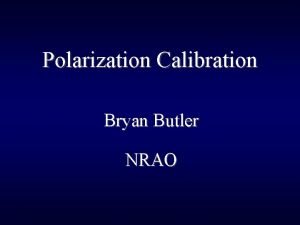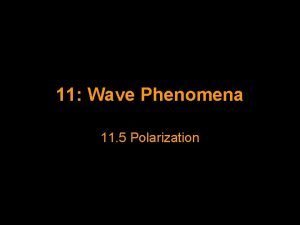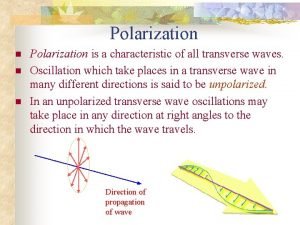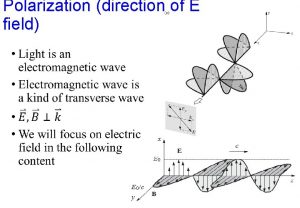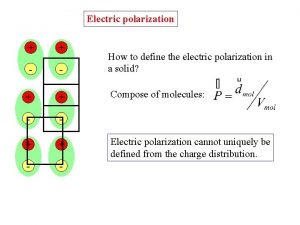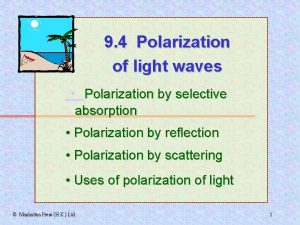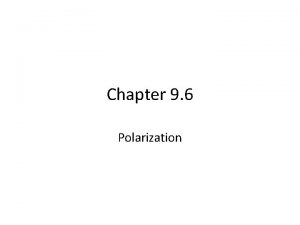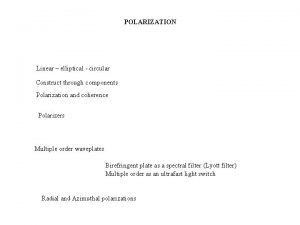Lecture 5 Polarization 5 1 5 0 Introduction

























- Slides: 25

Lecture 5 Polarization 5 - 1 5. 0 Introduction We have already established that light may be treated as a transverse electromagnetic wave. Thus far we have consider only linearly polarized or plane polarized light, that is light for which the orientation of the electric field is constant although its magnitude and sign varies in time. The electric field or optical disturbance therefore resides in what is known as the plane of vibration. That fixed plane contains both and , the electric field vector and the propagation vector in the direction of motion. Imagine now that we have two harmonic, linearly polarized waves of the same frequency, moving through the same direction. If their electric field vectors are collinear, the superimposing disturbances will simply combine to form a resultant linearly polarized wave. Its amplitude and phase were examined in detail, under a diversity of conditions in the previous chapter when we considered the phenomenon of interference. On contrary, if two light waves are such that their respective electric field directions are mutually perpendicular, the resultant wave may or may not be linearly polarized. Exactly what form that light will take(i. e its state of polarization), how we can observe it, produce it, change it and make use of it will be the concern of this chapter.

Lecture 5 Polarization 5 - 2 5. 1 Nature of polarized light 5. 1. 1 Linear polarization Fig. 5. 1(a) shows an electromagnetic wave with its electric field oscillating parallel to the vertical y axis. The plane containing the vector is called the plane of oscillation or vibration. We can represent the wave’s polarization by showing the extent of the electric field oscillations in a “head-on” view of the plane of oscillation, as in Fig. 5. 1 (b). Fig. 5. 1 (a) The plane of oscillation of a polarized electromagnetic wave. (b) To represent the polarization, we view the plane of oscillation “head-on” and indicate the amplitude of the oscillating electric field.

Consider two orthogonal optical disturbances 5 - 3 and where is the relative phase difference between the waves, both of which are traveling in the z-direction. The resultant optical disturbance is the vector sum of these two perpendicular waves: If or is an integral multiple of particular case Eq. 5. 3 becomes , the waves are said to be in phase. In that The resultant wave therefore has a fixed amplitude i. e it is a linearly polarized wave. , as shown in Fig. 5. 2. This process of addition can be carried out equally well in reverse; that is, we resolve any plane-polarized wave into two orthogonal components.

5 - 4 Fig. 5. 2 Linear light. This process of addition can be carried out equally well in reverse; that is, we resolve any plane-polarized wave into two orthogonal components. Suppose now that is and odd integer multiple of . The two waves are said to be 1800 out of phase and This wave is again a linearly polarized but the plane of polarization has been rotated from that of the previous case.

5. 1. 2 Circular polarization 5 - 5 Now we consider another particular case. That is, where , in addition, Accordingly, and The resultant wave is given by Notice now that the scalar amplitude of , which is equal to is a constant. But the direction of time varying and it is not restricted as before to a single plane. Let see what happens if and . Case 1: and for example, we will consider four cases when , , is

Case 2: 5 - 6 and 1 11 1 Case 3: Case 4: 1 21 1 and 1 41 1 and The resultant electric field vector 1 31 1 is rotating clockwise at an angular frequency of said to be right-circularly polarized. Figure (5. 3) below . Such a wave is

5 - 7 Fig 5. 3 Right-circular light. In comparison, if The amplitude is unaffected, but where then now rotates counter-clockwise, and the wave is referred to as left- circularly polarized. A linearly polarized wave can be synthesized from two oppositely polarized circular waves of equal amplitude. In particular, if we add Eq. 5. 7 to Eq. 5. 8, we get a linearly polarized wave,

5 - 8 5. 1. 3 Elliptical polarization Both linear and circular light may be considered to be special cases of elliptically polarized, or more simply, elliptical light. By that we mean that, in general, the resultant electric field vector rotate and change its magnitude as well. In such cases the endpoint of fixed plane perpendicular to will both will trace out an ellipse, in a as the wave sweeps by. We can better see this by actually writing an expression for the curves traverses by the tip of . To that end recall that and The equation of the curve we are looking for should neither be a function of position nor time, i. e we should be able to get rid of the Expand the expression of and combine it with dependence. into to yield

5 - 9 It follows from Eq. 5. 10 that So Eq. 5. 12 leads to Finally, on rearranging terms, we have This is the equation of an ellipse making an angle system (Fig. 5. 4) such that with the (Ex, Ey)-coordinate

5 - 10 Fig. 5. 4 Elliptical light. If or equivalently Furthermore, if we have familiar form this can be reduced to Clearly, it is a circle. If is an even multiple of , Eq. 5. 13 results in

And similarly for odd multiples of , 5 - 11 These are both straight lines having slopes of ; in other words, we have linear light. So, both linear and circular light may be considered to be special cases of elliptically polarized light. Fig. 5. 5 gives various polarization configurations. This very important diagram is labeled across the bottom “ leads by : ” where these are the positive values of to be used in Eq. 5. 2. Fig. 5. 5 (a) Various polarization configurations. (b). leads by , or alternatively , leads by .

5 - 12 We are now in a position to refer to a particular light wave in terms of its specific state of polarization. If the light is linearly, or plane polarized, then we say it is the P-state. Light that is right circularly polarized is in the R-state. Light that is left circularly polarized is in the L-state. Finally, elliptically polarized light is referred to as being in the E-state.

5 - 13 5. 1. 4 Natural light The electromagnetic waves emitted from any common source of light are polarized randomly or unpolarized. That is, the electric field changes directions randomly. We can use the mess like that in Fig. 5. 6 (a) to represent the unpolarized light. In principle, we can simplify the mess by resolving each electric field in Fig. 5. 6 (a) into y and z components and then finding the net fields along the two directions. In doing Fig. 5. 6 (a) and (b) Two different drawings to represent natural light.

5 - 14 so, we mathematically change unpolarized light into the superposition of two polarized waves whose planes of oscillation are perpendicular to each other. The result is the double-arrow representation of Fig. 5. 6 (b), which simplifies drawing of unpolarized light. Actually, light is generally neither completely polarized nor completely unpolarized. More often, the electric field vector varies in a way that is neither totally regular nor totally irregular, and one refers to such an optical disturbance as being partially polarized. For this situation, we can draw one of the arrows of the double-arrow representation longer than the other arrow.

5. 2 Polarizers 5 - 15 Now that we have some idea of what polarized light is, the next global step is to develop and understanding of the techniques used to generate it, change it, and in general manipulate it to feet our needs. An optical device whose input is natural light and whose output is some form of polarized light is a polarizer. Fig. 5. 7 A linear polarizer. Fig. 5. 7 shows a linear polarizer. Depending on the form of the output, we could also have circular or elliptical polarizers. Polarizing direction of a linear polarizer: An electric filed component parallel to the polarizing direction is passed (transmitted) by a polarizer; a component perpendicular to it is absorbed. Polarizers take on many different configurations as we shall see, but they are all based on one of four fundamental physical mechanisms: dichroism or selective absorption, reflection, scattering and birefringence or double refraction

5. 2. 1 Malu’s Law 5 - 16 Fig. 5. 7 A linear polarizer. How do we determine experimentally whether or not a device is actually a linear polarizer? By definition, if natural light is incident on an ideal linear polarizer Fig(5. 7), only light in a p-state will be transmitted. That P-state will have an orientation parallel to a specific direction which we will call the transmission axis of the polarizer. In order words, only the component of the optical field parallel to the transmission axis will pass through the device essentially unaffected. If the polarizer in Fig(5. 7) is rotated about the z-axis the reading of the detector (e. g a photocell) will be unchanged because of the complete symmetry of the unpolarized light. Because of the very high frequency of light the detector will, for practical reasons, measure only the incident irradiance. Since the irradiance is proportional to the square of the amplitude of the electric field( only concern ourselves with amplitude. ) we need

5. 2. 1 Malu’s Law 5 - 17 Now suppose that we introduce a second identical ideal polarizer or analyzer (Fig 5. 8) whose transmission axis is vertical. If the amplitude of the electric field transmitted by the polarizer is E 0, only its component E 0 cosθ, parallel to the transmission axis of the polarizer (Fig 5. 9) will be passed on to the detector(assuming no absorption). The irradiance reaching the detector is then given by θ is the angle between the polarizer P 1 and the analyzer P 2 Fig. 5. 9 Polarized light approaching a linear polarizer. Fig. 5. 8 A linear polarizer and analyzer.

5 - 18 The maximum irradiance, , occurs when the angle θ between the transmission axes of the analyzer and polarizer is zero. The expression can acccordingly be rewritten as This is known as Malus’s Law. If θ=90, then I(90)=0. This arises from the fact that the electric field that has passed through the polarizer is perpendicular to the transmission axis of the analyzer(the two devices so arranged are said to be crossed). The field is therefore parallel. That is called the extinction axis of the analyzer and hence obviously has no component along the transmission axis. The set-up of Fig (5. 8) can be used along with Malus’s Law to determine whether or not a particular device is in fact a linear polarizer.

5 - 19 Fig. 5. 10 Polarizing sunglasses consist of sheets whose polarizing directions are vertical when the sunglasses are worn. (a) Overlapping sunglasses transmit light fairly well when their polarizing directions have the same orientation, but (b) they block most of the light when ther are crossed.

5. 2. 2 Polarization by reflection 5 - 20 There is another way that we can produce hundred percent linearly polarized light, and we can do that by reflecting unpolarized light off a dielectric. For instance, water or glass. None of this follows from Snell’s, Snell’s Law was two hundred fifty years before Maxwell, polarization wasn’t even known in the days of Snell. But Maxwell’s equations allow you to properly deal with refraction and reflection including polarization. And I will take no attempt to derive this for ou in detail but I will present you wit some results so that you can a least appreciate the far-reaching consequences of the reflection in which we can produce a hundred percent polarized light. Suppose we have light unpolarized light coming in here, medium one , index of refraction n 1. ⏊ ⏊ refl inc θ 1 θ 2 ⏊ trans

5 - 21 The light is coming at an incident angle of θ 1 unpolarized. Some of it is reflected into medium 1 and the angle of reflection is θ 1. Some the light is refracted into medium 2(index of refraction n 2) and the angle of refraction is called θ 2. So this light, unpolarized, comes in, reflects and refracts. If we want to use Maxwell’s equation at the surface of the two media, we should decompose the electric vector of the incoming light in to two components. One which perpendicular to the plane of incidence(Same as the board), and the other parallel to the plane of incidence(in the board). We will have to do the same for the reflected and refracted light. The incident is unplarized so there is no preferred direction, that means that in the representation that we have the strength of the two component is equal, because if one were stronger than the other, then the light wouldn't be unpolarized. What Maxwell’s equations now can do for us is a lot of work. It can relate the parallel component in reflection with the parallel component of incidence, the parallel component of refraction with the parallel component of incidence. It gives two relations, two equations.

5 - 22 It can also relate the perpendicular component of the reflection component with the perpendicular component of incidence and the perpendicular component of refraction with the perpendicular component of incidence so we get another two sets of equations. Only one of the four equations will be given today. (5. 19) If we apply Snell’s Law equation (5. 19) can be simplify to (5. 20) There is something very special hidden in this equation and that is, when the downstairs of equation (5. 19) is infinitely large and so that means the parallel component in reflection is zero. So if in reflection goes to zero, there is only left, which is not zero and means the reflected light is now hundred percent polarized in this direction, because we have killed component completely.

But this only works if the condition is met. If the condition 5 - 23 is met then it follows from high school math that. If we remember Snell’s Law we can replace only for this case, by . Then we will have Equation (5. 21) is the secret to getting hundred percent polarized light, and the angle θ 1 is call the Brewster angle. If for instance we look at the transition from air to glass, glass has an index of refraction approximately 1. 5 depending of the kind of glass that you have. For that particular case the Brewster angle is about

5. 2. 3 Polarization by Dichroism 5 - 24 Dichroism is a selective absorption of one polarization plane over the other during the transmission through a material. In the laboratory, sheet polarizers or polaroids are the most used type of polarizers. They are manufactured from an organic material imbedded into plastic sheet. The sheet is stretched aligning molecules and causing them to be birefringent. The molecules selectively attach themselves to aligned polymer molecules, so that absorption is high in one plane and weak in the other. The transmitted beam is linearly polarized. 5. 2. 4 Polarization of scattered light Let us consider light passing through a gas. The oscillating electrons are separated by large distances and act independently of one another. If unpolarized light beam falls upon a gas and we are situated at right angles to them, we will see that scattered light is polarized. This situation is the one we see when we look at sunlight through a polarizer under a cloudless sky. We notice that it is partially polarized.

5. 2. 5 Polarization by double refraction 5 - 25 In gases, liquids, solids like glass or cubic crystals, the velocity of light, i. e the refraction index does not depend on the direction of propagation, they are said to be optically isotropic. Anisotropy means that one or many properties of a substance depend on direction, due to the arrangement of atoms being different in different directions throughout the volume. For example in many crystals the refractive index depends on direction of propagation. This is called “double refraction” or “birefringence”. A birefringent crystal such as calcite will divide an incident beam of monochromatic light into two separate beams having polarizations perpendicular to each other. The difference in behavior between the two beams may be used to make birefringent crystal polarizers.
 01:640:244 lecture notes - lecture 15: plat, idah, farad
01:640:244 lecture notes - lecture 15: plat, idah, farad Module 74 attribution attitudes and actions
Module 74 attribution attitudes and actions Group polarization example
Group polarization example Group polarization example
Group polarization example Charge polarization
Charge polarization Social inhibition
Social inhibition Groups tend to loaf less when
Groups tend to loaf less when Group polarization
Group polarization Group polarization vs groupthink
Group polarization vs groupthink Group polarization example
Group polarization example Depolarization vs polarization
Depolarization vs polarization Polarization ellipse equation
Polarization ellipse equation Jones vectors
Jones vectors Group polarization example
Group polarization example Polarization in physics
Polarization in physics Polarization in chemistry
Polarization in chemistry Depolarization factor
Depolarization factor Linear polarization
Linear polarization Light polarization equation
Light polarization equation Groupthink vs. group polarization
Groupthink vs. group polarization Concentration polarization
Concentration polarization Polarization index table
Polarization index table Diffraction and polarization
Diffraction and polarization Group polarization vs groupthink
Group polarization vs groupthink Hagen poiseuille equation
Hagen poiseuille equation State and prove poynting theorem
State and prove poynting theorem











